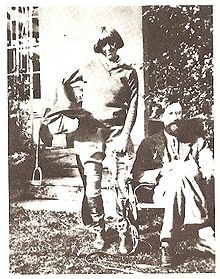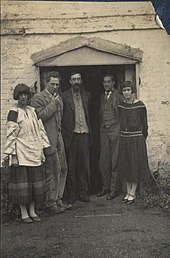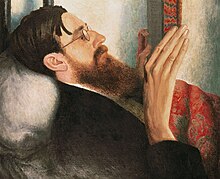Dora Carrington
Dora Carrington | |
|---|---|
 Carrington with Lytton Strachey | |
| Born | Dora de Houghton Carrington 29 March 1893 Hereford, England |
| Died | 11 March 1932 (aged 38) Newbury, Berkshire, England |
| Education | Slade School of Art |
| Alma mater | University College London |
Dora de Houghton Carrington (29 March 1893 – 11 March 1932), known generally as Carrington, was an English painter and decorative artist, remembered in part for her association with members of the Bloomsbury Group, especially the writer Lytton Strachey. From her time as an art student, she was known simply by her surname as she considered Dora to be "vulgar and sentimental".[1] She was not well known as a painter during her lifetime, as she rarely exhibited and did not sign her work. She worked for a while at the Omega Workshops, and for the Hogarth Press, designing woodcuts.[2]
Early life
[edit]Carrington was born in Hereford, England, to railway engineer Samuel Carrington, who worked for the East India Company, and Charlotte (née Houghton). They had married in 1888 and had five children together of whom Dora was their fourth.[3][1] She attended the all-girls' Bedford High School which emphasized art, and her parents paid for her to receive extra lessons in drawing. She won a number of awards in the national school competitions organised by the Royal Drawing Society.[1]
In 1910, she went to the Slade School of Art in central London where she subsequently won a scholarship and several other prizes; her fellow students included Dorothy Brett, Paul Nash, C. R. W. Nevinson and Mark Gertler.[4] All at one time or another were in love with her, as was Nash's younger brother John Nash, who hoped to marry her.[5][6] Gertler pursued Carrington for a number of years, and they had a brief sexual relationship during the years of the First World War.[7]
During 1912, Carrington attended a series of lectures by Mary Sargant Florence on fresco painting. The following year, she and Constance Lane completed three large frescoes for a library at Ashridge in the Chilterns.[1] Plans, with John and Paul Nash, for a cycle of frescoes for a church in Uxbridge near London came to nothing with the start of the War.[1] After graduating from the Slade, although short of money, Carrington stayed in London, living in Soho with a studio in Chelsea.[1] Her paintings were included in a number of group exhibitions, including with the New English Art Club, and she stopped signing and dating her work.[1] In 1914 Carrington's parents moved to Ibthorpe House in the village of Hurstbourne Tarrant in Hampshire, and shortly afterwards she moved there and set up her studio in an outbuilding.[1]
Career and personal life
[edit]

Carrington was not a member of the Bloomsbury Group, though she was closely associated with Bloomsbury and, more generally, with "Bohemian" attitudes, through her long relationship with the homosexual writer Lytton Strachey, whom she first met in 1916. Distinguished by her cropped pageboy hair style (before it was fashionable) and somewhat androgynous appearance, she was troubled by her sexuality; she is believed by some to have had an affair with Henrietta Bingham.[citation needed] She also had a significant relationship with the writer Gerald Brenan.
In June 1918, Virginia Woolf wrote of Carrington in her diary: "She is odd from her mixture of impulse & self consciousness. I wonder sometimes what she’s at: so eager to please, conciliatory, restless, & active.... [B]ut she is such a bustling eager creature, so red & solid, & at the same time inquisitive, that one can’t help liking her."[8] Carrington first set up house with Lytton Strachey in November 1917, when they moved together to Tidmarsh Mill House, near Pangbourne, Berkshire. Carrington met Ralph Partridge, an Oxford friend of her younger brother Noel, in 1918. Partridge fell in love with Carrington and eventually, in 1921, Carrington agreed to marry him, not for love but to hold the ménage à trois together.[9] Strachey paid for the wedding, and accompanied the couple on their honeymoon in Venice. The three moved to Ham Spray House in Wiltshire in 1924; the house had been purchased by Strachey in the name of Partridge.[10]
In 1926, Ralph Partridge began an affair with Frances Marshall, and left to live with her in London. His marriage to Carrington was effectively over, but he continued to visit her most weekends. In 1928 Carrington met Bernard Penrose, a friend of Partridge and the younger brother of the artist Roland Penrose, and began an affair with him. The affair energized Carrington's artistic creativity, and she also collaborated with Penrose on the making of three films. However, Penrose wanted Carrington exclusively for himself, a commitment she refused to make because of her love for Strachey. The affair, her last with a man, ended when Carrington became pregnant and had an abortion.

During her lifetime, Carrington's work received no critical attention. The lack of encouragement may have kept her from displaying her artwork. Carrington's work can be described as progressive, because it did not fit into the mainstream of art in England at the time. In fact, her work was not considered art at all. It featured Victorian-style pictures which were made from coloured tinfoil and paper. Carrington included pen sketches in letters to her friends, with the intention of entertaining them. She also created woodblock prints, which were highly regarded. Her lesser-known work included painted pub signs and murals, ceramics, fireplaces, and tin trunks.

Carrington was better known for her landscape paintings, which have been linked to surrealism. Her landscapes blend the facts of visual perception with interior desires and fantasies. One work of art, Mountain Ranges from Yegen, Andalusia, 1924, shows the split in perspectives. There is an intimate foreground, and there is in the distance a view of the mountains. The main focus, on the middle mountains, exhibit the texture of human skin. This merges the notion of the personal being made public.[11]
Relationship with Lytton Strachey
[edit]For many years, Carrington's art was neglected by the public, and her main notoriety was her relationship with Lytton Strachey. On the day that she agreed to marry Partridge she wrote to Strachey, who was in Italy, what has been described as "one of the most moving love letters in the English language".[12] She wrote, "I cried last night Lytton, whilst he slept by my side sleeping happily—I cried to think of a savage cynical fate which had made it impossible for my love ever to be used by you...". Strachey wrote back that "you do know very well that I love you as something more than a friend, you angelic creature, whose goodness to me has made me happy for years, and whose presence in my life has been and always will be, one of the most important things in my life ...".[13] On his deathbed Strachey said, "I always wanted to marry Carrington and I never did". His biographer calls that sentiment "not true; but he could not have said anything more deeply consoling".[14] Upon his death, Strachey left Carrington £10,000 (roughly the equivalent of £576,000 in 2023).[15]
Death
[edit]
Dora Carrington died by suicide on 11 March 1932, two months after Strachey's death, using a gun borrowed from her friend, Hon. Bryan Guinness (later 2nd Baron Moyne).[4] Her body was cremated and the ashes buried under the laurels in the garden of Ham Spray House.
Legacy
[edit]An accomplished painter of portraits, landscape and still-life, Carrington also worked in applied and decorative arts, painting on any type of surface she had at hand including inn signs, tiles and furniture. She also decorated pottery and designed the library at Ham Spray. In 1970 David Garnett published a selection of letters and extracts from her diary, since which time critical and popular appreciation of her work has risen sharply.[16] In 1978, Sir John Rothenstein, for nearly thirty years Director of the Tate Gallery, London, called Dora Carrington "the most neglected serious painter of her time."[17] Carrington was one of the five artists featured in the television series Five Women Painters made in 1989 by the Arts Council and Channel 4,[18] with accompanying book published by Lennard.[19] In 1995 she was the subject of a major retrospective exhibition at the Barbican Art Gallery in London[20] and in 2024–2025 there was another retrospective at the Pallant House Gallery in Chichester, co-curated by Anne Chisholm and Ariane Banks.[21] Two of her works are in the Tate Gallery.[22]
In popular culture
[edit]Books
[edit]- Diana Mitford, a close friend, profiles Carrington in Loved Ones (1985).
- Gerald Brenan writes about Carrington's visit to him in Spain in his 1957 autobiographical work South from Granada.
- In his first novel Crome Yellow, Aldous Huxley based the character of Mary Bracegirdle on Carrington, and described how she and he slept on the roof of "Lollipop Hall", based on Lady Ottoline Morrell's home. He chose the name "Bracegirdle" because of Dora's chastity.[1]
- Carrington is the inspiration for the character Elinor Brooke in Pat Barker's trilogy of novels, Life Class (2008), Toby's Room (2013) and Noonday (2016).
Radio: Portrayed by Morwenna Banks as 'Barrington' in 'Gloomsbury' by Sue Limb, a five part series parodying the Bloomsbury Group on BBC Radio 4, 2012-2018.
Films
[edit]- Emma Thompson portrays Carrington in the 1995 British biographical film Carrington, written and directed by Christopher Hampton based on the book Lytton Strachey by Michael Holroyd.
- Jessica Kate Meyer portrays Carrington in the 2003 Goya Award winning Spanish film Al sur de Granada, written and directed by Fernando Colomo, based on the 1957 autobiographical book South from Granada by Gerald Brenan.
References
[edit]- ^ a b c d e f g h i Jane Hill (1994). The Art of Dora Carrington. The Herbert Press. ISBN 9780713657265.
- ^ "Dora de Houghton Carrington: An Inventory of Her Collection at the Harry Ransom Humanities Research Center". norman.hrc.utexas.edu. Carrington, Noel, Gertler, Marjorie, Gertler, Mark, 1891-1939, John, Augustus, 1878-1961, Lamb, Henry, 1883-1960, Nevinson, C. R. W. (Christopher Richard Wynne), 1889-1946. Retrieved 15 January 2018.
{{cite web}}: CS1 maint: others (link) - ^ "The Oxford Dictionary of National Biography". Oxford Dictionary of National Biography (online ed.). Oxford University Press. 2004. doi:10.1093/ref:odnb/37262. (Subscription or UK public library membership required.)
- ^ a b David Boyd Haycock (2009). A Crisis of Brilliance: Five Young British Artists and the Great War. Old Street Publishing (London). ISBN 978-1-905847-84-6.
- ^ "Dora Carrington: a difficult virus to get out of your system". The Independent. London. 23 October 1999. Retrieved 7 November 2017.
- ^ "Dora Carrington :: Biography (1893-1932) :: Gallery :: Canvas Prints". leninimports.com. Retrieved 15 January 2018.
- ^ "Dora Carrington – an outline of her life – painter, designer, bohemian, bisexual". mantex. Archived from the original on 23 February 2014. Retrieved 30 May 2020.
- ^ Ann Olivier Bell (ed.) (1977), The Diary of Virginia Woolf, Vol. I: 1915–1919 (London: The Hogarth Press), p. 153.
- ^ "Lytton Strachey: The New Biography" by Michael Holroyd, 1994, p. 485.
- ^ Gretchen Holbrook Gerzina (1989). Carrington - A Life. p. 299.
- ^ Elinor, Gillian (Spring–Summer 1984). "Vanessa Bell and Dora Carrington:Bloomsbury Painters". Woman's Art Journal. 5 (Woman's Art Inc): 28–43. doi:10.2307/1357882. JSTOR 1357882.
- ^ French, Sean (28 August 1994). "For consenting adults: 'Lytton Strachey: The New Biography' – Michael Holroyd". The Independent. London. Retrieved 15 February 2011.
- ^ "Lytton Strachey--The New Biography" by Michael Holroyd, 1994, pp. 486–487.
- ^ "Lytton Strachey--The New Biography" by Michael Holroyd, 1994, p. 678.
- ^ "Lytton Strachey--The New Biography" by Michael Holroyd, 1994, pp. 686, 531.
- ^ Gretchen Holbrook Gerzina (1989). Carrington - A Life. p. xv.
- ^ Noel Carrington, Carrington Paintings, Drawings, and Decorations [1978], p. 14.
- ^ "Five Women Painters part 2: Carrington". Arts on Film Archive. University of Westminster. Archived from the original on 19 July 2021. Retrieved 19 July 2021.
- ^ Grimes, Teresa; Collins, Judith; Baddeley, Oriana; Arts Council of Great Britain (1989). Five women painters. Oxford: Lennard Publishing. ISBN 1-85291-083-6. OCLC 28891861.
- ^ "Dora Carrington". Davis & Langdale Company, Inc. Retrieved 17 April 2014.
- ^ "Dora Carrington: Beyond Bloomsbury". Pallant House Gallery. 2 January 2025. Retrieved 31 December 2024.
- ^ "Art and artists: Artworks". Tate. Retrieved 17 April 2014.
Further reading
[edit]- Noel Carrington. Carrington, Paintings, Drawings and Decorations. Oxford: Oxford Polytechnic Press, 1978; New York, Thames & Hudson, 1980. Foreword by Sir John Rothenstein.
- (in Spanish) Gerald Brenan. Diarios sobre Dora Carrington y otros escritos (1925-1932). Editorial Confluencias, 2012.
- Maria Tamboukou. Visual Lives: Dora Carrington’s Letters, Drawings and Paintings. BSA Auto/Biography Study Group, 2010 (Auto/Biography Monograph Series).
Archival sources
[edit]- Dora Carrington Collection, 1912-1965 (1.67 linear feet) are housed at the Harry Ransom Center at the University of Texas at Austin
- Lytton Strachey collection of papers, 1904-1934 (596 items) are housed at the New York Public Library
- Gerald Brenan Collection, 1911-1978 (8.75 linear feet) are housed at the Harry Ransom Center at the University of Texas at Austin
External links
[edit]- 19 artworks by or after Dora Carrington at the Art UK site
- The Grove Dictionary of Art
- Farm at Watendlath (1921)
- Dora Carrington Collection Archived 18 February 2012 at the Wayback Machine at the Harry Ransom Center at the University of Texas at Austin
- 'Carrington (and Woolf) in Cambridge, 1928', by Peter Murray Jones, Transactions of the Cambridge Bibliographical Society, Vol.XIII Pt.3, 2006
- "Archival material relating to Dora Carrington". UK National Archives.
- Portraits of Dora Carrington at the National Portrait Gallery, London
- 1893 births
- 1932 suicides
- 1932 deaths
- 20th-century English painters
- 20th-century English women artists
- 20th-century English LGBTQ people
- Alumni of the Slade School of Fine Art
- Artists who died by suicide
- Bloomsbury Group
- English LGBTQ painters
- LGBTQ people who died by suicide
- People educated at Bedford High School, Bedfordshire
- People from Hereford
- Suicides by firearm in England
- 20th-century English women painters
